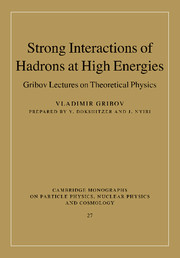Book contents
- Frontmatter
- Contents
- Foreword
- 1 Introduction
- 2 Analyticity and unitarity
- 3 Resonances
- 4 Electromagnetic interaction of hadrons
- 5 Strong interactions at high energies
- 6 t-channel unitarity and growing interaction radius
- 7 Theory of complex angular momenta
- 8 Reggeon exchange
- 9 Regge poles in perturbation theory
- 10 Regge pole beyond perturbation theory
- 11 Reggeon branchings
- 12 Branchings in the s channel and shadowing
- 13 Interacting reggeons
- 14 Reggeon field theory
- 15 Particle density fluctuations and RFT
- 16 Strong interactions and field theory
- Postscript
- References
- Index
3 - Resonances
- Frontmatter
- Contents
- Foreword
- 1 Introduction
- 2 Analyticity and unitarity
- 3 Resonances
- 4 Electromagnetic interaction of hadrons
- 5 Strong interactions at high energies
- 6 t-channel unitarity and growing interaction radius
- 7 Theory of complex angular momenta
- 8 Reggeon exchange
- 9 Regge poles in perturbation theory
- 10 Regge pole beyond perturbation theory
- 11 Reggeon branchings
- 12 Branchings in the s channel and shadowing
- 13 Interacting reggeons
- 14 Reggeon field theory
- 15 Particle density fluctuations and RFT
- 16 Strong interactions and field theory
- Postscript
- References
- Index
Summary
How to examine unphysical sheets of the amplitude
In the previous lecture we have discussed in detail that owing to unitarity, analyticity and crossing symmetry — the general properties of the theory — all the physics of hadron interactions is determined, in principle, by the spectrum of real particles.
We saw that the interaction constant — the measure of the interaction strength — entered only as a residue in the pole of the scattering amplitude. Can it be true that the plethora of phenomena in the hadron world is described by a single quantitative characteristic — the residue?
This situation looks strange and profoundly unsatisfactory from a theoretical point of view. It makes one wonder whether there is not something hidden beyond the mass spectrum that we have introduced.
Philosophy aside, it is important to know how the amplitude behaves in the vicinity of the cut. We cannot say a priori that it changes smoothly there, since the question of smoothness of a multi-valued function is a delicate one.
If we position ourselves near the cut on the physical sheet then, rather close in the energy variable, we have an unphysical sheet about which nothing had been said so far. If there is a singularity (for example, a pole) on the unphysical sheet close to the physical one, the amplitude on the physical sheet would be changing fast.
- Type
- Chapter
- Information
- Strong Interactions of Hadrons at High EnergiesGribov Lectures on Theoretical Physics, pp. 73 - 91Publisher: Cambridge University PressPrint publication year: 2008



